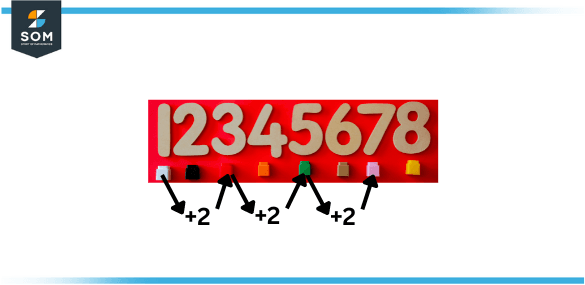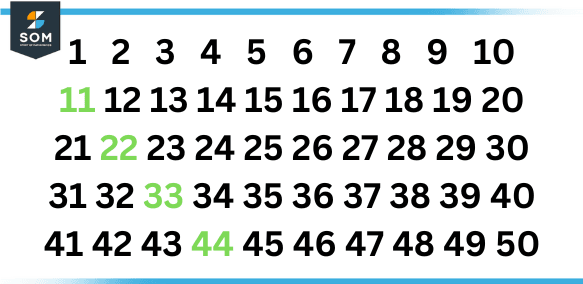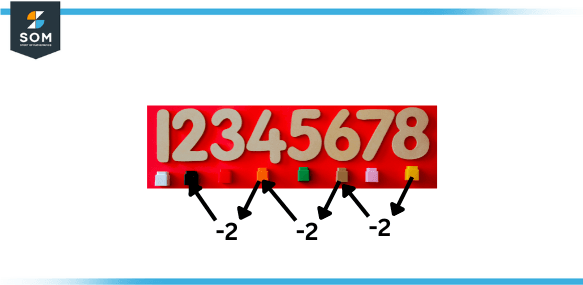JUMP TO TOPIC
Skip Counting|Definition & Meaning
Definition
Skip counting is when we skip ahead or behind by a certain amount when counting numbers. For a skip of 1, this is just normal counting like 1, 2, 3, …, but when we skip count by 2 (or count by 2s), we get 1, 3, 5, and so on. Recording the results of skip counting results in an arithmetic sequence of integers with a common difference equal to the skipped count.
One good way to get a grip on skip counting is by counting out loud using a specific interval. For example, starting at zero, a child might say “0, 2, 4, 6, 8” to count by twos, or “0, 5, 10, 15” to count by fives. This helps children to become familiar with the pattern of the numbers, and to learn to count quickly and efficiently.
Another way to practice skip counting is through the use of visual aids, such as a number chart or a skip counting worksheet.
These tools provide children with a visual representation of the numbers, and can help them to see the pattern of the numbers more clearly. This can be especially helpful for children who struggle with memorization or have difficulty understanding abstract concepts.

Figure 1: Skip Counting by 2
In addition to helping with basic arithmetic, skip counting can also be used as a foundation for more advanced mathematical concepts. For example, it can be used to teach multiplication and division and can also be used to help children understand the concept of skip counting by tens, hundreds, or thousands.
It is important to note that the practice of skip counting can be challenging for some children, especially those who are struggling with basic arithmetic. However, with patience and consistent practice, children can master this skill and become more confident in their mathematical abilities.
Skip Counting by Larger Numbers
Skip counting by larger numbers is a technique used to count numbers by intervals greater than ten. This method is used to count by larger numbers such as twelves, the twenties, and hundreds. It is a useful tool for children who have mastered basic skip counting and are ready to take on more challenging mathematical concepts.

Figure 2: Skip Counting by 11
An easier way to practice skip counting by larger numbers is to use a number chart or a skip counting worksheet that includes larger numbers. These tools can help children to see the pattern of the numbers more clearly and can help them to understand the relationships between numbers.
For example, starting at zero, a child might say “0, 20, 40, 60, 80” to count by twenties or “0, 100, 200, 300, 400” to count by hundreds.
Another way to practice skip counting by larger numbers is through the use of real-world examples. For example, counting the number of items in a group of 12, counting the number of cars in a parking lot of 24, or counting the number of apples in a box of 36. This helps children to understand the concept of skip counting in a practical context and can make it more engaging and meaningful for them.
As children become more comfortable with skip counting by larger numbers, they can begin to apply this skill to more advanced mathematical concepts such as multiplication and division. For example, they can use skip counting to find the product of 12 x 3 or the quotient of 36 / 6.
It’s important to note that skip counting by larger numbers can be challenging for some children and may require more practice and patience to master. However, with consistent practice, children can improve their ability to work with larger numbers and gain a deeper understanding of mathematical concepts.
However, skip counting by larger numbers is a valuable tool that can help children to develop their mathematical skills and improve their ability to work with larger numbers. By using a variety of methods, such as using visual aids, incorporating real-world examples, and incorporating skip counting into other mathematical concepts, children can gain a deeper understanding of numbers and improve their ability to work with them.
Backward Skip Counting
Backward skip counting is a technique used to count numbers in reverse order by a specific interval. This method is often used to count down by twos, fives, or tens and is also helpful for children learning basic arithmetic.

Figure 3: Backward Skip Counting by 2
Just like forwards skip counting, one common way to practice backward skip counting is by counting out loud using a specific interval.
For example, starting at a larger number, a child might say “10, 8, 6, 4, 2” to count backward by twos or “20, 15, 10, 5” to count backward by fives. This helps children to become familiar with the pattern of the numbers in reverse order and to learn to count backward quickly and efficiently.
And the other way to practice backward skip counting is through the use of visual aids, such as a number chart or a backward skip counting worksheet, just like forward skip counting.
These tools provide children with a visual representation of the numbers in reverse order and can help them to see the pattern of the numbers more clearly.
In conclusion, skip counting is a valuable tool that can help children to develop their mathematical skills and improve their ability to work with numbers.
By using a variety of methods, such as counting out loud, using visual aids, and incorporating skip counting into other mathematical concepts, children can gain a deeper understanding of numbers and improve their ability to work with them.
A Few Examples of Skip Counting
Example 1
Q: Count by fives starting at 20 and ending at 50.
Solution
The solution to this question would be: 20, 25, 30, 35, 40, 45, 50
This problem can be solved by simply starting at 20 and adding 5 each time to the previous number, following the pattern of counting by fives. This is an example of skip counting, and it can help children to become familiar with the pattern of the numbers and to learn to count quickly and efficiently.
Example 2
Q: Count backward by twos starting at 20 and ending at 0.
Solution
The solution to this question would be: 20, 18, 16, 14, 12, 10, 8, 6, 4, 2, 0
This problem can be solved by simply starting at 20 and subtracting 2 each time from the previous number, following the pattern of counting backward by twos. This is an example of backward skip counting, and it can help children to become familiar with the pattern of the numbers in reverse order and to learn to count backward quickly and efficiently.
All mathematical drawings and images were created with GeoGebra.
